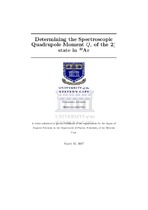Determining the Spectroscopic Quadrupole Moment Qs of the 2+1 state in 40Ar
Abstract
The rst reorientation-e ect Coulomb-excitation experiment has been
performed at iThemba LABS by bombarding 40Ar beams on a heavy
208Pb target at a \safe" energy of Elab =143.2 MeV. The goal was to
determine, the spectroscopic quadrupole moment, QS , of the rst excita-
tion 2+
1 at 1.461 MeV in 40Ar at \safe" energies. The scattered particles
were detected at backward angles using a double-sided CD-type S3 silicon
detector, composed of 24 rings and 32 sectors for angular distribution and
Doppler correction, respectively, in coincidence with de-excited
rays
collected by 8 clover detectors in the AFRODITE array. The collected
coincidence data were analysed using a state-of-the-art sorting code spe-
cially developed for this kind of measurements, which allowed, by setting
up di erent energy and time conditions, a clean
-ray spectrum for further
analysis with the Coulomb-excitation coupled-channels code, GOSIA. A
diagonal matrix element of h2+
1 j jE^2 j j2+
1 i = +0:047(22) eb has been
determined, which yields QS (2+
1 ) = +0:036(17) eb, after detailed GOSIA
analysis and minimisation. This value is 8.5 times more precise than the
only previous measurement of QS (2+
1 ) = +0:01(4) eb by Nakai and col-
laborators in 1970, and further supports the zig-zag of quadrupole shapes
observed at the end of the sd shell. A possible explanation regards the
in
uence of proton holes driving the nuclear shape towards an oblate con-
guration.

